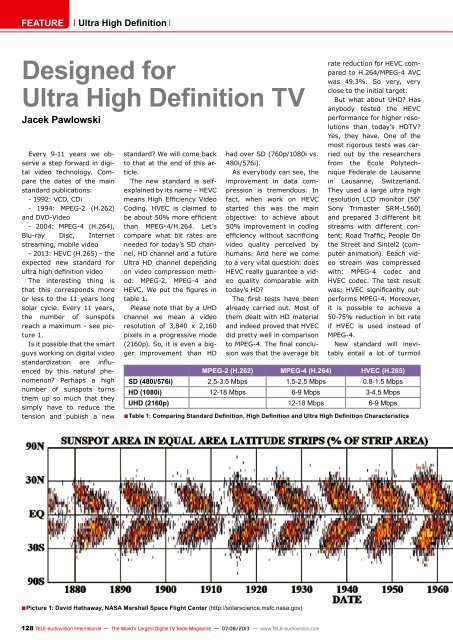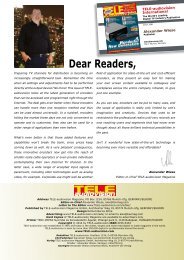eng TELE-audiovision 1307
The World’s Largest Digital TV Trade Magazine
The World’s Largest Digital TV Trade Magazine
Create successful ePaper yourself
Turn your PDF publications into a flip-book with our unique Google optimized e-Paper software.
FEATURE Ultra High Definition<br />
Designed for<br />
Ultra High Definition TV<br />
Jacek pawlowski<br />
Every 9-11 years we observe<br />
a step forward in digital<br />
video technology. Compare<br />
the dates of the main<br />
standard publications:<br />
- 1992: VCD, CDi<br />
- 1994: MPEG-2 (H.262)<br />
and DVD-Video<br />
- 2004: MPEG-4 (H.264),<br />
Blu-ray Disc, Internet<br />
streaming, mobile video<br />
- 2013: HEVC (H.265) - the<br />
expected new standard for<br />
ultra high definition video<br />
The interesting thing is<br />
that this corresponds more<br />
or less to the 11 years long<br />
solar cycle. Every 11 years,<br />
the number of sunspots<br />
reach a maximum - see picture<br />
1.<br />
Is it possible that the smart<br />
guys working on digital video<br />
standardization are influenced<br />
by this natural phenomenon?<br />
Perhaps a high<br />
number of sunspots turns<br />
them up so much that they<br />
simply have to reduce the<br />
tension and publish a new<br />
■<br />
standard? We will come back<br />
to that at the end of this article.<br />
The new standard is selfexplained<br />
by its name – HEVC<br />
means High Efficiency Video<br />
Coding. HVEC is claimed to<br />
be about 50% more efficient<br />
than MPEG-4/H.264. Let’s<br />
compare what bit rates are<br />
needed for today’s SD channel,<br />
HD channel and a future<br />
Ultra HD channel depending<br />
on video compression method:<br />
MPEG-2, MPEG-4 and<br />
HEVC. We put the figures in<br />
table 1.<br />
Please note that by a UHD<br />
channel we mean a video<br />
resolution of 3,840 x 2,160<br />
pixels in a progressive mode<br />
(2160p). So, it is even a bigger<br />
improvement than HD<br />
■<br />
had over SD (760p/1080i vs.<br />
480i/576i).<br />
As everybody can see, the<br />
improvement in data compression<br />
is tremendous. In<br />
fact, when work on HEVC<br />
started this was the main<br />
objective: to achieve about<br />
50% improvement in coding<br />
efficiency without sacrificing<br />
video quality perceived by<br />
humans. And here we come<br />
to a very vital question: does<br />
HEVC really guarantee a video<br />
quality comparable with<br />
today’s HD?<br />
The first tests have been<br />
already carried out. Most of<br />
them dealt with HD material<br />
and indeed proved that HVEC<br />
did pretty well in comparison<br />
to MPEG-4. The final conclusion<br />
was that the average bit<br />
picture 1: David Hathaway, NASA Marshall Space Flight center (http://solarscience.msfc.nasa.gov)<br />
128 <strong>TELE</strong>-<strong>audiovision</strong> International — The World‘s Largest Digital TV Trade Magazine — 07-08/2013 — www.<strong>TELE</strong>-<strong>audiovision</strong>.com<br />
rate reduction for HEVC compared<br />
to H.264/MPEG-4 AVC<br />
was 49.3%. So very, very<br />
close to the initial target.<br />
But what about UHD? Has<br />
anybody tested the HEVC<br />
performance for higher resolutions<br />
than today’s HDTV?<br />
Yes, they have. One of the<br />
most rigorous tests was carried<br />
out by the researchers<br />
from the Ecole Polytechnique<br />
Federale de Lausanne<br />
in Lausanne, Switzerland.<br />
They used a large ultra high<br />
resolution LCD monitor (56”<br />
Sony Trimaster SRM-L560)<br />
and prepared 3 different bit<br />
streams with different content:<br />
Road Traffic, People On<br />
the Street and Sintel2 (computer<br />
animation). Eeach video<br />
stream was compressed<br />
with: MPEG-4 codec and<br />
HVEC codec. The test result<br />
was: HVEC significantly outperforms<br />
MPEG-4. Moreover,<br />
it is possible to achieve a<br />
50-75% reduction in bit rate<br />
if HVEC is used instead of<br />
MPEG-4.<br />
New standard will inevitably<br />
entail a lot of turmoil<br />
MpEG-2 (H.262) MpEG-4 (H.264) HvEc (H.265)<br />
SD (480i/576i) 2.5-3.5 Mbps 1.5-2.5 Mbps 0.8-1.5 Mbps<br />
HD (1080i) 12-18 Mbps 6-9 Mbps 3-4.5 Mbps<br />
UHD (2160p) 12-18 Mbps 6-9 Mbps<br />
Table 1: Comparing Standard Definition, High Definition and Ultra High Definition Characteristics


















